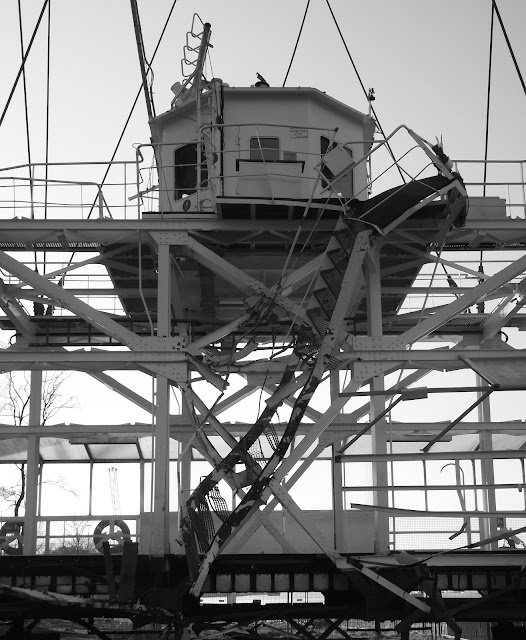Archaeology : Architecture : Art : Cold War : Curiosities : Design : Eccentricities : Ekco : Engineering : Industrial Heritage : Military : Petroliana : Photography : Shed Wonders : Transporter Bridges : Vintage Technology
17 February 2016
Rendsburg Transporter Bridge, Schleswig-Holstein
The Rendsburg High Bridge was the last of the three transporter bridges built in Germany: Osten opened in 1909 and remains in use, Kiel opened in 1910 but was demolished in 1923, and Rendsburg opened in 1913 and remains in use.
Designed by Friedrich Voss, construction began in 1911. The bridge was, and is, unique, in that it is properly a railway viaduct, carrying the Neumünster-Flensburg line over the Kiel Canal. From the central bridge (above) is slung a gondola such that the structure doubles as a transporter bridge.
Because the bridge carries a railway, a maximum incline of 1:150 was required. Accordingly, the whole structure is about 4.7 miles long, including the approach embankments. The trussed steel viaduct (first and last photos) boasts a total length of 8,156 feet, an incredible 1.5 miles.
The cantilevered central bridge is 966.5 feet long and has a main span of 459 feet. The towers are 164 feet high, and the bridge provides clearance above the canal water of 138 feet. A design quirk of the viaduct is that on the north side of the canal the 360-degree Rendsburg Loop carries the railway down to Rendsburg Station, at ground level.
The transporter bridge operates daily, making it one of just seven bridges worldwide still operating in transporter form. The journey between Osterrönfeld and Rendsburg takes just 90 seconds, and is repeated every quarter of an hour.
Regrettably, the gondola, which can carry four cars, but is largely used by pedestrians and cyclists, was in January 2016 struck by a cargo ship and badly damaged (above). At the time of writing, the transporter bridge was as a result not operating.
Osten Transporter Bridge, Lower Saxony
Osten Transporter Bridge was built 1908-09 to provide a crossing between Osten and Hemmoor that did not interfere with shipping on the River Oste. It is one of only 19 transporter bridges ever built to completion worldwide, and was the first of three in Germany: Osten (in use), Kiel (opened 1910, dismantled 1923), and Rendsburg (in use).
With a span of 259 feet, and a width of 32 feet, the bridge is of truss construction. The structure is symmetrical but for the overhang on the Osten side of the river (below).
Unusually for a transporter bridge, the gondola (next two photos) is suspended from the moving trolley by way of solid steel latticework, instead of the usual cables. Large compared to the modest scale of the bridge, the gondola can transport either 100 people or six cars at a time.
The foundations were laid by a local constructor, and the steelwork was fabricated by MAN (Maschinenfabrik Augsburg-Nürnberg) at Gustavsburg. AEG (Allgemeine Elektricitäts-Gesellschaft) of Berlin undertook the work to provide electric traction, as in a tram.
The bridge operated on a regular basis until 1974. It was listed as a Technical Monument in 1975. Taken out of service in 2001 because of extensive rust damage, the bridge was recommissioned in 2006.
Now operated as a tourist attraction from April to October, Osten is one of only nine survivors from the 19, and of only seven transporter bridges still operational in their original form. A small museum devoted to the bridge can be found on the Osten side.
16 February 2016
Chilehaus, Hamburg
Ten-storeys tall and built using 4,800,000 dark Oldenburg bricks, the Chilehaus is an internationally famous example of Expressionist architecture.
Built between 1922 and 1924 to the designs of Fritz Höger, the building, although curving along a whole block in the form of a passenger ship, has great verticality.
The tiered balconies to the top three floors were set back to mimic ship decks, but also enabled the circumvention of height restrictions.
The site is very close to the River Elbe, and construction required reinforced concrete pilings 52 feet deep. There are over 2,800 windows.
Built between 1922 and 1924 to the designs of Fritz Höger, the building, although curving along a whole block in the form of a passenger ship, has great verticality.
The tiered balconies to the top three floors were set back to mimic ship decks, but also enabled the circumvention of height restrictions.
The site is very close to the River Elbe, and construction required reinforced concrete pilings 52 feet deep. There are over 2,800 windows.
Labels:
Architecture,
Art,
Design,
Engineering















